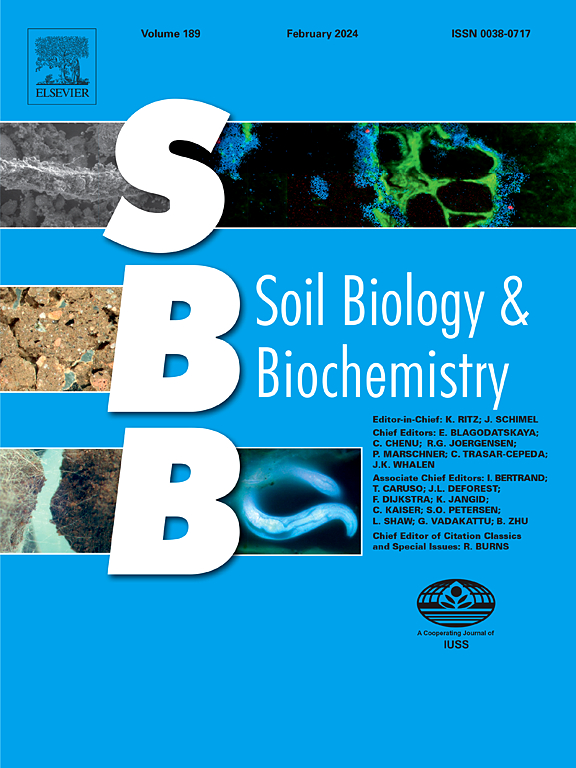Carbon pathways in soil: unraveled by 13C natural abundance
IF 9.8
1区 农林科学
Q1 SOIL SCIENCE
引用次数: 0
Abstract
Soil organic matter (SOM) escapes microbial and enzymatic decomposition by stabilizing on clays and iron- and aluminum (oxyhydro)oxides, or by being trapped within aggregates. We analyzed the importance of these stabilization mechanisms based on 13C natural discrimination within SOM pools and generalized the transformations by evaluating 1190 δ13C data for aggregates and 365 for density fractions. The key approach is based on the increase of the δ13C values of the pools with their transformation intensity and their stability. The main directions of C flow across the land use types and climates are from macro- towards microaggregates and to silt + clay, as well as from free light through occluded light to occluded dense fractions and finally to mineral-associated organic matter (MAOM). The strongest 13C enrichment (+1.1 ‰) between occluded light and dense fractions shows that more than one transformation step occurred between these pools during the SOM formation from litter. Considering the heaviest Δ13C signature (as difference between δ13Cfraction and δ13Cbulk soil), we conclude that the MAOM is the most stable pool in all soils globally, highlighting the leading role of fixation of organic compounds on minerals as long-term C stabilization. Clay content, pH, and climate shape microbial activities, regulating SOM transformation and 13C discrimination. Land use regulates organic inputs and soil disturbance, altering microbial recycling and the δ13C signature of the transformation products. Concluding, the pathways of litter-derived C to stable SOM within aggregates and density fractions are similar in a broad range of soils globally. These processes, however, are modified by the edaphic factors, land use, and climate, affecting long-term C stabilization.

土壤中的碳路径:由13C自然丰度解开
土壤有机质(SOM)通过稳定在粘土和铁铝(氢氧化物)氧化物上,或被困在团聚体中,逃避微生物和酶的分解。我们分析了这些稳定机制的重要性,这些机制基于SOM池中13C的自然区别,并通过评估1,190个聚集体和365个密度分数的δ13C数据进行了概括。这一关键方法是基于池的δ13C值随着池的转变强度和稳定性的增加而增加。C在不同土地利用类型和气候条件下的主要流动方向是宏观-微团聚体-粉土+粘土,自由光-被遮挡光-被遮挡密,最后到矿物伴生有机质(MAOM)组分。在被遮挡的轻质组分和致密组分之间,13C富集最强(+1.1‰),表明在凋落物形成SOM的过程中,这些池之间发生了不止一个转化步骤。考虑到最重的Δ13C特征(δ13Cfraction和δ13Cbulk之间的差异),我们得出结论,MAOM是全球所有土壤中最稳定的库,突出了有机化合物在矿物上的固定作用作为长期稳定的主导作用。粘土含量、pH和气候影响微生物活动,调节SOM转化和13C识别。土地利用调节有机投入和土壤扰动,改变微生物循环和转化产物的δ13C特征。综上所述,在全球广泛的土壤中,凋落物来源的C在团聚体和密度组分中向稳定SOM的路径是相似的。然而,这些过程受到土壤因素、土地利用和气候的影响,影响长期的碳稳定。
本文章由计算机程序翻译,如有差异,请以英文原文为准。
求助全文
约1分钟内获得全文
求助全文
来源期刊

Soil Biology & Biochemistry
农林科学-土壤科学
CiteScore
16.90
自引率
9.30%
发文量
312
审稿时长
49 days
期刊介绍:
Soil Biology & Biochemistry publishes original research articles of international significance focusing on biological processes in soil and their applications to soil and environmental quality. Major topics include the ecology and biochemical processes of soil organisms, their effects on the environment, and interactions with plants. The journal also welcomes state-of-the-art reviews and discussions on contemporary research in soil biology and biochemistry.
 求助内容:
求助内容: 应助结果提醒方式:
应助结果提醒方式:


